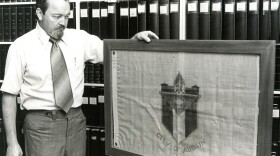After a prolonged absence, the Paramount Theatre’s once-iconic sign will light up Congress Avenue tonight for the first time in 51 years.
The “blade,” as it’s known, was decommissioned in 1964, when it was decided the sign, which had been in place for over 30 years, didn’t quite gel with the aesthetic of the newly installed marquee – that, and it was a pain to change the towering sign’s numerous bulbs. But, before it was the Paramount, the theater was a cog in a statewide vaudeville circuit, nearly closed twice and was saved by a man who later became a Cold War culture warrior.

Austin’s lauded theater opened in 1915 under a different moniker: the Majestic Theater. Unlike many theaters of its time, the Majestic was a locally owned endeavor that required $150,000 in investment before the curtains rose on October 11.
The theater’s name, however, wasn’t entirely original. The Majestic Theaters in Dallas, Waco, Houston and San Antonio had been around for a few years prior, and were owned by the Interstate Theater Circuit – a corporation started by Missourian Karl Hoblitzelle, an entrepreneur who built theaters around the Vaudeville circuits in the South.
Ten years in, the theater had hosted the Marx brothers and Harry Houdini. A few years later, in 1930, its distributor Publix — the distribution arm of film studio Paramount Pictures — revamped the space and gave it a new name. But, as the Great Depression took hold, theaters saw declining revenues. Hoblitzelle, who owned the lion’s share of theaters in Texas, had sold his stable of theaters to RKO Pictures shortly before retiring in 1929. As both Paramount and RKO approached bankruptcy, Hoblitzelle came out of retirement and consolidated all the theaters, effectively buying up all the theaters in Texas’ major cities.

By the end of the ‘30s, the theater competition had increased, but many considered Hoblitzelle’s Interstate Theater Circuit a monopoly. Its parent company, Paramount, was targeted by an anti-trust suit in 1939. Still, Hoblitzelle managed to weather the decade-long legal battle, and a 1949 Supreme Court decision ultimately busted up Paramount into two arms – one for production and distribution, the other for actually screening, or “exhibiting,” the movies.
Hoblitzelle later went on to expand his business interests to finance, real estate and oil and gas, all the while supporting scores of charitable organizations and universities. His death in 1967, however, was overshadowed by a scandal surrounding the foundation that bore his namesake, the Hoblitzelle Foundation, after accusations that it was a “funnel” for CIA counter-intelligence efforts in the U.S. and in Europe.
After Hobitzelle’s death, and the rise of suburban theaters, the Paramount fell into disrepair, later to be rescued by a handful of Austinites. When the theater had been scheduled for demolition, John Bernardoni, Charles Eckerman and Stephen Scott stepped in with plans to restore it back to its former glory.
Below, you can listen to the Texas Standard’s interview with Bernardoni:
Tonight, the Paramount will relight a replica sign to celebrate its centennial. The whereabouts of the Paramount’s original sign are still a mystery, but The Statesman lamented the sign’s descent in March of 1964:
The big sign, like the dinosaur, finally fell victim to its own size and unwieldiness when the tedious job of relamping the many-bulbed sign became an expendable inconvenience and when its rococo appearance seemed incongruous to the Paramount’s modern new marquee. The theater plans a more compact name sign for its façade, but to Austin oldtimers, the downtown scene at night could hardly look the same.




